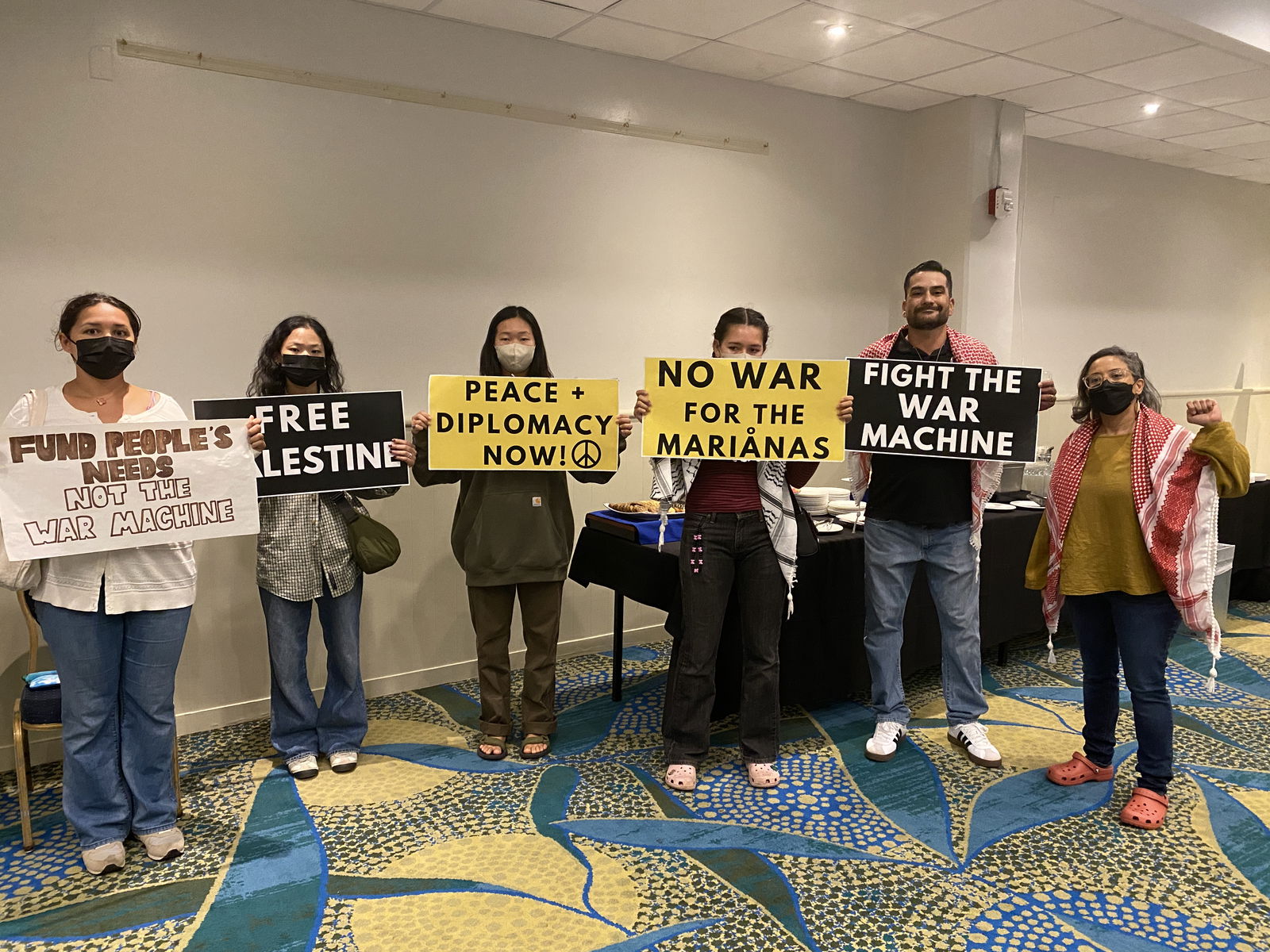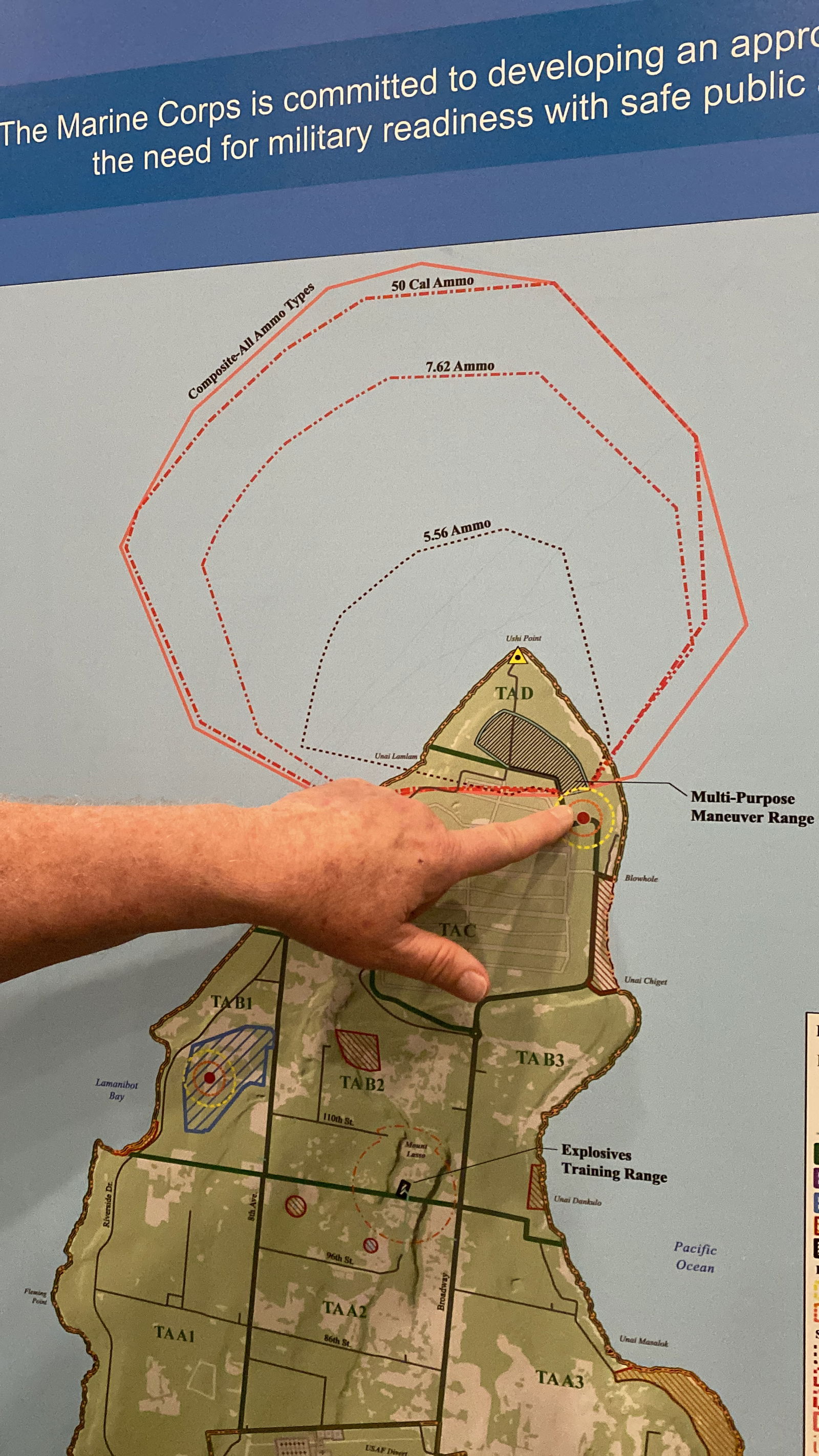SAIPAN residents met with subject matter experts on the revised Draft Environmental Impact Statement for the Commonwealth of the Northern Mariana Islands Joint Military Training or CNMI JMT project during a public consultation held Wednesday at the Crowne Plaza Resort.
At the same time and venue, protesters held signs opposing militarization in the CNMI.
Since June 6, the U.S. Marine Corps has opened a 75-day public comment period for the revised EIS.
According to a fact sheet distributed at the event, the proposed action would utilize the Military Lease Area or MLA on Tinian to establish live-fire training ranges at the island’s northern tip. It would also create a Training Area and a Range Operations Command — or “range control” — on Tinian. The purpose of range control, the Marines said, is to coordinate the military use of the MLA while allowing civilian access “when it may safely be accommodated, even during ongoing training events.”
Range safety and access
Variety spoke with Carlos Hatchcock, a range safety and design expert, who presented on range control.
He said range control would assign Marines to coordinate with local authorities on civilian access. Even while Marines use one part of the MLA, Hatchcock said, civilians would still be able to access other areas.
The MLA would be divided into eight training areas, and no fences would be built to keep people out, he added.
“What range control means for the Marine Corps is that authority over the ranges in the complex,” Hatchcock said. “Their primary focus is safety, as well as scheduling and tracking what’s happening within the training areas. One of the major differences here is that this range complex is designed to accommodate civilian and military use at the same time.”
He noted, however, that when the northern firing range is in use, boaters and fishermen would be required to avoid a designated hazard zone in part of the Saipan-Tinian Channel. The size of the hazard zone would depend on the ammunition used — for example, .50 caliber rounds would require a larger safety buffer than 5.56mm rounds.
“Most bullets will land within the range and around the targets, but this is our safety area because we are training,” Hatchcock said. “We want to make sure we keep both participants and non-participants safe.”
Expanded training scope
Julie Chen, a program manager for the EIS, told Variety that the Marines want the MLA to support “land-based expeditionary ground warfare,” which she described as training in the “natural environment.” Aviation warfare training is also part of the revised proposal, according to the fact sheet.
The proposed action includes construction of two live-fire ranges, a multipurpose maneuver range and an explosives training range; two surface radar towers; multiple landing zones; improvements to North Field, including a drop zone between runways Able and Charlie; and two ammunition holding areas.
The former U.S. Agency for Global Media facility and communication towers on Tinian would be repurposed into an expeditionary base camp. Additional projects include a biosecurity facility at the Port of Tinian and an aircraft shelter on U.S. Air Force Divert lease property.
Business perspective
Saipan Chamber of Commerce President Joe Guerrero also attended the event. He said local businesses could benefit from the military buildup but emphasized that potential negative impacts must be addressed early.
“The Chamber has always supported efforts for local businesses to benefit from opportunities tied to the Department of Defense presence,” Guerrero said. “At the same time, it’s important that any impacts to the business community — and the community in general — are mitigated and addressed upfront so we make fewer mistakes as we go along.”
He added that dialogue events like this are key to encouraging public feedback.
‘Significantly different’ EIS
Retired Maj. Gen. Mark Hashimoto, executive director of Marine Corps Forces Pacific, said the revised EIS is “significantly different with much lower impact than what was proposed 10 years ago,” crediting community feedback for many of the changes.
“One of the primary reasons for that was that the voice of the community was heard,” Hashimoto said.
He added: “We wanted to say how impressed we are by the strength of your culture and community. That has reminded us of the connectedness of this place. That sense of connectedness has guided our conversations over the last decade and brought us to a place where we can protect the land for future generations.”
The public is encouraged to submit comments on the revised EIS at: https://tinyurl.com/EISComments. The comment period ends Aug. 20.
Protests continue
Beginning shortly after 5 p.m., as doors opened for the event, local residents held posters and staged a silent protest against militarization in the Marianas and Palestine.
Anufat Pangelinan, one of the protesters, spoke to the media. He linked militarization to global environmental and humanitarian crises.
“From my experience as a student of environmental sciences, many of the world’s major issues — famine, climate change, sea level rise, carbon emissions — can be traced back to early colonization. Today, they largely trace back to one of the world’s largest greenhouse gas emitters: the U.S. military and military-industrial complex,” he said.
“As a son of the Marianas, I don’t want to be another cog in the machine that profits off war and the deaths of innocent civilians. I don’t want our islands to be the tip of the spear — I’d rather we be a bridge for peace.”
Pangelinan also voiced concern about the CNMI economy becoming overly dependent on federal and military funding.
“We’ll become so complacent that we’ll give up land just for the promise of a slightly higher GDP,” he said. “And we’ll be the first to be attacked if conflict breaks out in the Pacific.”
“The more we present ourselves as a military community, the bigger the target we place on our islands. That’s why I’m strongly opposed to this project. It shouldn’t go forward.”

Saipan residents meet with subject-matter experts on the revised Draft Environmental Impact Statement for Commonwealth of the Northern Mariana Islands Joint Military Training or CNMI JMT.

Anufat Pangelinan, right, protests the militarization of the CNMI.

Island residents hold posters and silently protested militarization in the Marianas and Palestine.

Since June 6, the U.S. Marine Corps has opened a 75-day public comment period for the revised EIS.

Carlos Hatchcock points out how some of the waters adjacent to Tinian will be closed to boaters and fishermen when live fire training occurs on the island’s north portion.

Retired Maj. Gen. Mark Hashimoto, executive director of Marine Corp Forces Pacific, said the revised EIS “is significantly different with much lower impact than what was proposed 10 years ago.”











